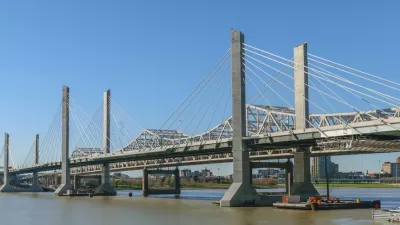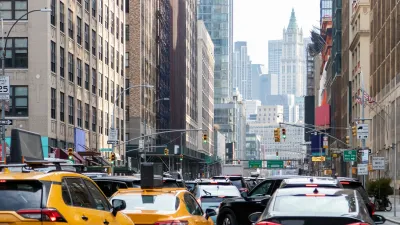Many in the urbanism community were shocked to see the scale of the recently completed "Spaghetti Junction" in Louisville, but the tolling system that will fund the project is just as critical to consider.
Joe Cortright provides context to the news about the recently completed Louisville-Southern Indiana Ohio River Bridges Project, which has quickly gained a level of notoriety thanks to a series of aerial photos of the project's "Spaghetti Junction" released by the Courier-Journal.
According to Cortright, however, "there’s another feature of the new bridge project that we think may be even more egregious than the concrete pasta of the re-built interchange: the new tolling structure that will repay the cost of building the new bridges."
Before explaining the tolling system that will help fund the construction of the bridges, Cortright explains the long planning history that created the Louisville-Southern Indiana Ohio River Bridges Project, but to summarize one main point: the Louisville area now has five bridges crossing the Ohio River. The first problem with the new tolling system is that some of those bridges will be tolled, and some won't.
A larger problem, however, comes from the commuter discount, which creates incentives for driving more frequently, especially toward the end of the month. Then there's the flat rate drivers will pay to cross the river: "since the proposed Louisville tolls don’t vary by time of day, you pay the same price whether you use one of the new bridges at the height of the rush hour, or in the wee hours of the morning when no one else is one the road. This flat-rate tolling structure misses a major opportunity to better manage demand and improve the overall functioning of the transportation system."
Cortright concludes by predicting neither revenue nor congestion will be improved by the tolling system that will go into effect December 30.
FULL STORY: For whom the bridge tolls

Planetizen Federal Action Tracker
A weekly monitor of how Trump’s orders and actions are impacting planners and planning in America.

San Francisco's School District Spent $105M To Build Affordable Housing for Teachers — And That's Just the Beginning
SFUSD joins a growing list of school districts using their land holdings to address housing affordability challenges faced by their own employees.

The Tiny, Adorable $7,000 Car Turning Japan Onto EVs
The single seat Mibot charges from a regular plug as quickly as an iPad, and is about half the price of an average EV.

As Trump Phases Out FEMA, Is It Time to Flee the Floodplains?
With less federal funding available for disaster relief efforts, the need to relocate at-risk communities is more urgent than ever.

With Protected Lanes, 460% More People Commute by Bike
For those needing more ammo, more data proving what we already knew is here.

In More Metros Than You’d Think, Suburbs are Now More Expensive Than the City
If you're moving to the burbs to save on square footage, data shows you should think again.
Urban Design for Planners 1: Software Tools
This six-course series explores essential urban design concepts using open source software and equips planners with the tools they need to participate fully in the urban design process.
Planning for Universal Design
Learn the tools for implementing Universal Design in planning regulations.
Smith Gee Studio
City of Charlotte
City of Camden Redevelopment Agency
City of Astoria
Transportation Research & Education Center (TREC) at Portland State University
US High Speed Rail Association
City of Camden Redevelopment Agency
Municipality of Princeton (NJ)





























